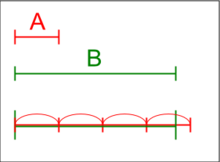Archimedes' axiom
The so-called Archimedean axiom is named after the ancient mathematician Archimedes , but it is older and was formulated by Eudoxus of Knidos in his theory of sizes. In modern terms it reads as follows:
- For every two quantities there is a natural number with .
Geometrically, the axiom can be interpreted as follows: If you have two segments on a straight line, you can surpass the larger of the two if you only remove the smaller one often enough.
An ordered group or an ordered body , in which the Archimedean axiom applies, is called Archimedean (an) ordered .
For the field of real numbers it is sometimes introduced axiomatically . However, one can prove with the axioms of an ordered body and the supremum axiom ( every upwardly restricted subset of the body has a supremum ) that the real numbers are ordered Archimedes.
Proof from the supremum axiom for an ordered body
Be it
Assertion: For each there is a natural number such that it holds.
Counter-assumption: There is a such that for all natural numbers
From the opposite assumption it follows that for all natural numbers there is an upper bound for . With the supremum axiom it follows from this the existence of a smallest upper bound . But if it applies to all natural numbers , then it also applies, and thus also to all natural numbers . But then there is also an upper bound for . Because of , is not a smallest upper bound, which contradicts the definition of . Thus the counter-assumption must be wrong and the claim is proven.
Consequences from the Archimedean axiom
For every number there is such that and . It follows that for every there exists a unique number with
It is denoted by or . There is also a clearly defined number with
which is denoted by or . This also applies: for everyone there is a with and therefore vice versa . This relationship is useful in analysis, for example to demonstrate the convergence or divergence of sequences .
Furthermore, it follows from the Archimedean axiom that for two real numbers always a rational number with are, and that the set of natural numbers in the body is not limited to above.
Archimedean ordered groups
An ordered group is a group with a (here written additively) link and an order structure compatible with the group structure .
The two axioms apply to the order structure:
Für alle gilt , das heißt ist reflexiv. Aus und folgt für alle , das heißt ist transitiv.
In addition there is the axiom of group compatibility :
Aus folgt für alle .
An ordered group is ordered according to Archimedes if:
Zu je zwei Elementen und der Gruppe mit existiert eine natürliche Zahl mit .
Holder's theorem
Every Archimedean ordered group is commutative and isomorphic to an additively ordered subgroup of .
The figure is for a group linkage written with e> 0 and additively
an isomorphism of G into an additive ordered subgroup of , where for and and for and .
The element e can be used as a unit with which each group element can be "measured". This means: For each element of the group there is one such that .
Example : The intervals in music theory form an Archimedean ordered commutative group and can all be measured with the unit octave or cent . See: tone structure .
Classification : Either an Archimedean ordered group G is of the form G = {0} or G = {…, −3a, −2a, −a, 0, a, 2a, 3a, ...} (isomorphic to the additive group of the whole Numbers) or there is no smallest element, which is specified in the following.
There is a with for each element . (If there is no minimal positive , then there is certainly a with for each . If you can choose. If there is a with and if holds for the inequality .)
Non-Archimedean arranged bodies
An example of an arranged field in which the axiom of Archimedes does not apply is the field of hyperreal numbers studied in nonstandard analysis .
A simpler example consists of the rational functions over the rational (or real) number field, which are ordered so that is greater than all numbers (this can be done in a unique way).
Historical
In the elements in Book 3 Proposition 16, Euclid gives an explicit example of quantities that do not fulfill Archimedes' axiom, so - called horn - shaped angles that are formed by touching curved curves, in Euclid's example by a circle and its tangent. They only appear at this point in the elements.
Web links
Individual evidence
- ↑ Narrated in: Euclid, elements V, definition 4: That they have a relationship to one another is said of quantities which, when multiplied, exceed one another.
- ↑ Otto Hölder The axioms of quantity and the doctrine of measure , Ber. Verh. Saxon Society of Sciences Leipzig, Math. Phys. Class, Volume 53, 1901, pp. 1-64.
- ↑ Alexander Gennadjewitsch Kurosch lectures on general algebra. Harri Deutsch, Zurich 1964.
- ^ Euclid, Book 3, Proposition 16, in David Joyce
- ^ Felix Klein Elementary Mathematics from the Higher Viewpoint , Springer Verlag, Volume 2, pp. 221f.





































































